|
|
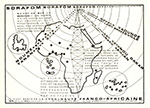 |
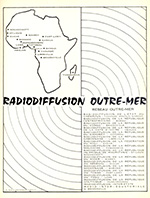 |
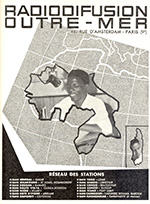 |
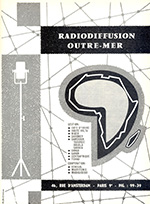 |
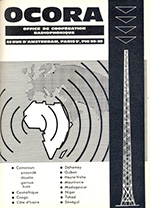 |
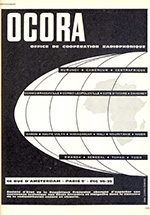 |
|
| 1959 | 1960 | 1961 | 1962 | 1963 | 1964 | 1965-68 |
| (Click on any image above) | ||||||
IIn the mid-1950s, most of the countries of French West Africa (Afrique Occidentale Française, or A.O.F.) and French Equatorial Africa (Afrique Equatoriale Française, or A.E.F.), and some points beyond, were anticipating independence from France, a goal that was reached for many by the end of the decade. To support the development of broadcasting in these territories, France established the Société de Radiodiffusion de la France d'Outre-Mer, or SORAFOM. It was not a broadcasting network, but rather a service that provided technical, administrative and programming assistance. In 1962, SORAFOM was refashioned as the Office de Coopération Radiophonique, or OCORA. Eventually (1969) it was taken over by ORTF, but it remained alive, mainly through its work in the preservation of ethnic music worldwide. Judging from the WRTH advertisements at the top of the page (click on images to enlarge), the membership in SORAFOM/ OCORA year to year was relatively stable, but with some exceptions. New Caledonia, Tahiti, St. Pierre and Miquelon, Djibouti, Dzaoudzi (Comores), and Atar (Mauritania), all of which are shown on the SORAFOM card, were included in the 1959 ad, but in no subsequent ads. Togo was omitted in 1962, 1963 and 1964, and Bamako (Mali) in 1962 and 1963, but they were included in other years. Guinea, which had a somewhat different relationship with France, was excluded in all years except 1959 and 1964. Interestingly, three countries which were French speaking but formerly colonies of Belgium, not France, were included in later years: Rwanda in 1964 and 1965-68, and Burundi and Congo-Leopoldville (Kinshasa) in 1965-68. One of the services that SORAFOM provided was to supply member stations with QSL-cards. The blue-and-gold design was uniform—a map of Africa showing SORAFOM station locations, with insets for three stations outside Africa--New Caledonia, Tahiti, and St. Pierre and Miquelon. The name of the particular station using the card was printed at the top left, and there was a verification statement, and space for frequency and power information, on the back. The cards were either filled out by hand or typed, and soon they started showing up in DXers' mailboxes (real mailboxes in those days—no email). When it took over from SORAFOM, OCORA continued to make QSLs available to member stations. The design was different but similar: a brown, black and gold card, a map of Africa on the front, with white dots at the various member station locations (but without any names, and with their own station's dot in black), the station name at the top, and a verification statement and room for schedule information on the back. A few stations created their own variations on this theme. A previously-posted set of SORAFOM schedules from 1960 can be found here, and appears to contain the answer to a small mystery on the OCORA card, as well as a bit of Although many of the SORAFOM stations operated with relatively low power, typically 4 kw., in the 1950s and 1960s they were quite well heard on the east coast of North America, and well beyond. Their signals, which were often in the 60 meter "DX band," were dependable markers (no digital readout back then), and helped in judging propagational conditions. The stations were also good verifiers, perhaps because, in the SORAFOM days, many of them were new to shortwave. Not every member station used the SORAFOM and OCORA cards—some had their own cards, or replied by letter—but most used them, especially in the SORAFOM days. The OCORA card had fewer users, but it was standard to see both cards in the QSL collections of active DXers of the day. Below is a compilation of many of the SORAFOM and OCORA cards, and some brief notes about the stations. I have included some of my own QSLs, and I want to thank Bruce Churchill, John Ekwall (Sweden), Hartmut Engemann (Germany), Rich McVicar, and Anker Petersen (Denmark) for providing others. Thanks as well to DSWCI for the QSLs of Danish DXer Niels Jakob Jensen (thanks, Anker); to the ARDXC/NFSA QSL Collection for the QSLs of N. Hughes of Australia (thanks, Sam Dellit); to Broadcast QSLs Online for the Mali QSL of Helmut Schönert; and to Sverige DX-Förbund (SDXF) for the Ivory Coast QSL of Börge Eriksson. Remember to click on the QSL images to bring them up to full size. At the bottom of this display we have included a couple of examples of SORAFOM reporting cards (non-QSLs). |
| FRENCH WEST AFRICA | ||
| Note: ▼ Click on any QSL image to enlarge. | ||
| DAHOMEY | ||
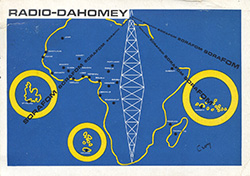 |
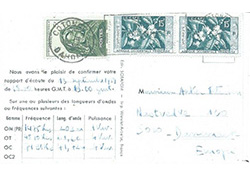 |
Radio Cotonou, as it was sometimes called back then, came on shortwave in 1953. At that time the WRTH showed it on 7315 kHz. with 250 watts, but by the time of this QSL in 1959, home base was 4870 kHz., power 4 kw. |
Power was still 4 kw. at the time of this DXer's reception in August 1961, but it soon increased to 30 kw. In 1969 the station could be heard with an English lesson at 0600 UTC. Four years later the station was renamed La Voix de la Révolution, and Dahomey itself was renamed Benin in 1975. It remained on shortwave until around 2009. | ||
| FRENCH CAMEROUN | ||
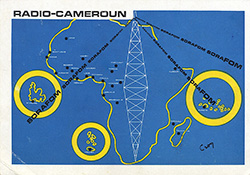 |
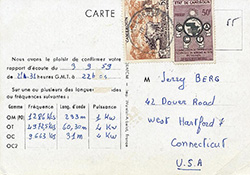 |
It appears that Cameroun first came on the air in 1941, and on shortwave in 1946 via a 600 watt transmitter in Douala (soon increased to 1 kw.). It remained the only shortwave station in Cameroun until 1955, when a second station was opened, in Yaounde, the country's capital. Douala went off shortwave in 1968, returning with 100 kw. in 1983. It was heard until around 1994. Following its opening, Yaounde became the country's "national" voice. It began operation using transmitters of 1 kw. on mediumwave and 4 kw. on shortwave, going to 30 kw. on shortwave in 1962, and 100 kw. in 1977. Yaounde was last heard in early 2000, following several periods of inactivity. |
The SORAFOM QSL at the top left, from 1959, is for 4972.5 kHz., which was one of Yaounde's best-heard channels. The OCORA card is from 1961. | ||
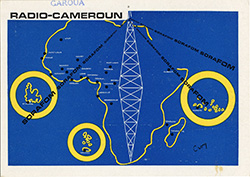 |
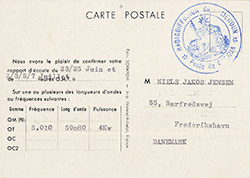 |
Garoua started broadcasting in 1958. The best-heard shortwave frequency throughout its life was 5010 kHz., which used 4 kw. until 1964, when power was increased to 30 kw. It increased again, to 100 kw., in 1977. Garoua was on shortwave until around 1999. The undated SORAFOM card at left is the standard SORAFOM "Radio Cameroun" QSL, but "Garoua" has been hand stamped above the station name on the front. A Garoua bullseye stamp appears on the back. |
This OCORA card is from 1966. Over the years, other Cameroun stations operated on shortwave from Buea, Bertoua and Bafoussam, but that was long after the SORAFOM-OCORA years. (Some of the above information comes from "Brief History of Shortwave Broadcasting in Cameroon," authored by Tony Rogers and posted on the British DX Club website ("Articles Index Page"). Thanks to both for permission to use it here. And be sure to check out Tony's excellent "DX Guides" at www.dxguides.info.) | ||
| IVORY COAST | ||
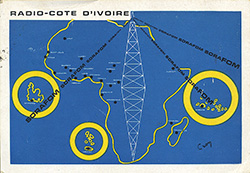 |
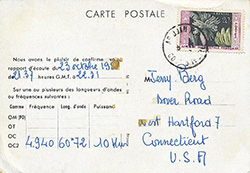 |
It used 1 kw., maybe less, when Radio Abidjan came on shortwave in 1952, after being on mediumwave for a couple of years. It soon went to 5 kw., then 10 kw. around 1955, making the 60 meter frequency where it eventually settled, 4940 kHz., widely heard, and one of the first channels to fade in during east coast afternoons. In the mid-70s it would also be well heard on 11920 kHz. It left shortwave around 2001. This QSL is for 1958 reception. |
This Ivory Coast OCORA card is from 1961. Abidjan's QSL-card from pre-SORAFOM days was quite distinctive, and can be seen here. | ||
| MALI | ||
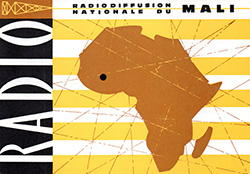 |
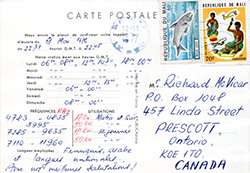 |
Mali, formerly the French Sudan, has been on shortwave since 1957, but it was on mediumwave long before that. This QSL is from 1977, and is a variation on the standard OCORA design, with all of the OCORA station dots omitted except Bamako, the Mali station's location. The back of the QSL is the standard OCORA format. Mali is one of the few SORAFOM-OCORA stations that is still on shortwave. |
In some places, the basic OCORA design survived for a long time, but in modified form, as evidenced by this 1986 card from Bamako. The colors and the basic design are the same, but the focus is entirely on the Bamako station, with the standard OCORA "RADIO" along the left side replaced by "RTM." The back is nearly identical to the standard OCORA card. | ||
| MAURITANIA | ||
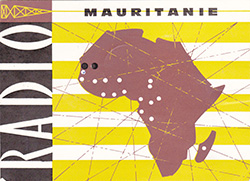 |
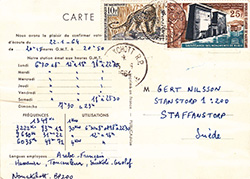 |
Mauritania is believed to have come on the air in 1957, and on shortwave circa 1959, the year before its independence. The transmitter was located in St. Louis, Senegal, but the station eventually got its own installation at Nouakchott, which was named the country's capital as independence grew near (until then Mauritania had no capital). This QSL is from 1964. The station's eventual frequency, 4845 kHz., would be a major presence in the 60 meter band for many years, especially after it went to 100 kw. circa 1973. Mauritania left shortwave around 2012. |
| NIGER | ||
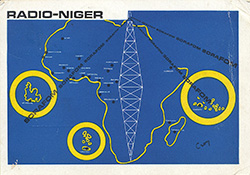 |
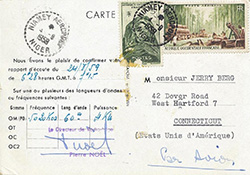 |
Niamey came on shortwave in 1958 on 5020 kHz. with a reliable, 4 kw. signal. This QSL is from 1959. Many years later, in the 1990s, the station would be known as La Voix du Sahel, by which time it had a 100 kw. transmitter. The 5020 kHz. channel left the air around 2001, but thereafter the station could still be heard on 9705. It left shortwave around 2013. |
| SENEGAL | ||
Senegal preceded most of the French African shortwave broadcasters, coming on air in 1940 as Radio Dakar. This 1959 QSL is for one of the station's then networks, Radio-Inter-A.O.F. Senegal used many frequencies over the years, and was one of the first French Africans to use 100 kw. for some of its broadcasts. That was in 1960.
| ||
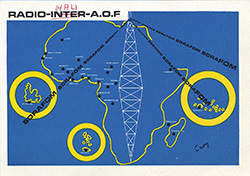 |
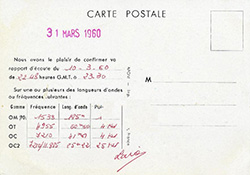 |
Senegal and the French Sudan formed the Mali Federation in April 1959. As a result, Senegal's Radio-Inter-A.O.F. became Radio-Mali-A.O.F., with "Inter" crossed out on QSLs and "Mali" penned in (see left). The federation lasted only until August 19, 1960 (after which the French Sudan changed its name to Mali). |
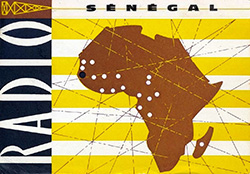 |
This card is from Google Images, where the description dates it as 1960, but there is no other information. Senegal left shortwave around 1997, after long periods of intermittent operation. | |
| TOGO | ||
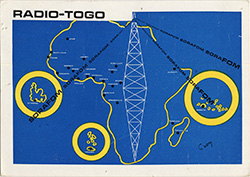 |
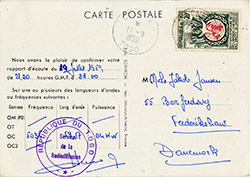 |
Togo came on shortwave in 1956, on 5036 kHz., 1 kw., soon increased to 4 kw. Before long, transmissions would settle on 5047, a channel on which the station would provide a strong signal for decades. |
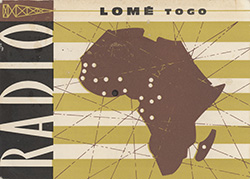 |
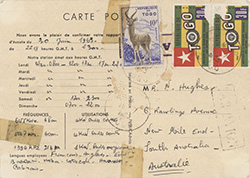 |
Togo obtained a 100 kw. transmitter in 1963 (they were apparently still using 4 kw. when this QSL was issued for reception that year). In 1975, another Togo shortwave station came on the air, from Lama-Kara. Togo left shortwave circa 2004. |
| UPPER VOLTA | ||
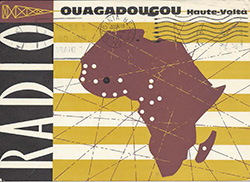 |
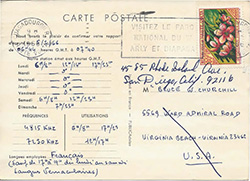 |
Upper Volta, or Haute-Volta, and its capital, Ougadougou, were pretty exotic sounding places when they came on shortwave circa 1959. And the country's new name in 1984, Burkina Faso, was only slightly less so. The station was still at its original 4 kw. in 1966, when this QSL was issued, but after several interim power increases it reached 100 kw. around 2002. It left shortwave in 2010. |
| FRENCH EQUATORIAL AFRICA | ||
| CENTRAL AFRICAN REPUBLIC | ||
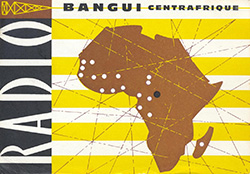 |
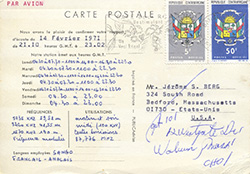 |
The C.A.R. has been known by several names: Ubangi-Shari, Central African Republic (1958), Central African Empire (1976-79), then back to C.A.R. It came on shortwave in 1958 with 3 kw., soon increasing power to 4 kw., then 30, then, in 1971, 100 kw. It was a long-time presence around 5035 kHz., not leaving shortwave until around 2011. |
| CONGO (BRAZZAVILLE) | ||
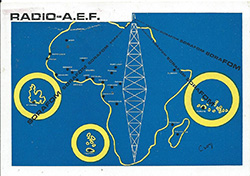 |
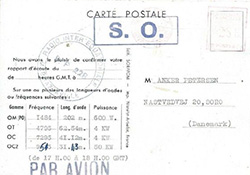 |
French West Africa had its "Radio-Inter-A.O.F." (Afrique Occidentale Française), and French Equatorial Africa had "Radio-A.E.F." (Afrique Equatoriale Française), located in Brazzaville. This was not the World War II "Free French" Radio Brazzaville, but rather a local Brazzaville service that appears to have started up around 1951. This card was received in less than two weeks for June 1959 reception. Around that time the station adopted the name "Radio Inter Equatoriale," as evidenced by the bullseye stamp on the back. |
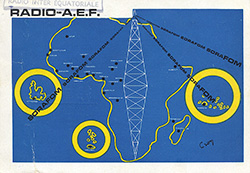 |
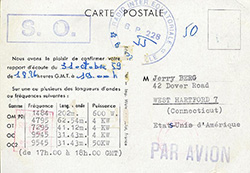 |
This card, also from 1959, has the same bullseye, but the "Radio Inter Equatoriale" name is also stamped above "Radio-A.E.F." on the front. |
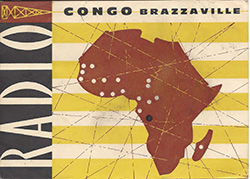 |
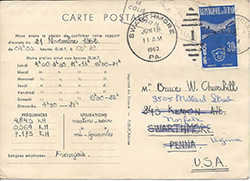 |
Radio Inter Equatoriale was short lived. In 1960, it had morphed into Radio Congo. This card is from 1963. |
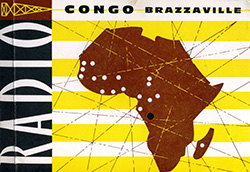 |
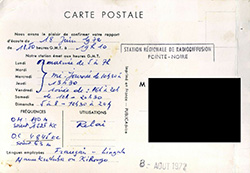 |
Although it says Brazzaville on the front, the hand stamp on the back identifies this OCORA QSL as coming from "Station Régionale de Radiodiffusion Pointe Noire." Pointe Noire is a coastal city, whereas Brazzaville is located some 300 miles up the Congo River. The approximate period of Pointe Noire's operation was 1969-1984. It was heard on 4843 kHz., and operated with 4 kw. |
| GABON | ||
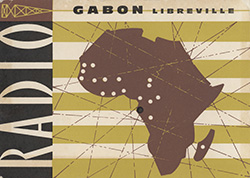 |
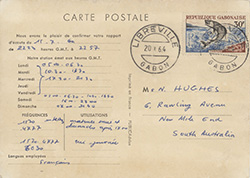 |
Gabon came on shortwave in 1959, at first with 4 kw., then 30 kw., then, in 1970, 100 kw. It was a regular signal on 4777 kHz., where it would transmit for nearly 50 years, until around 2008. (A larger station, Africa No. 1, kept Gabon on shortwave until around 2013.) |
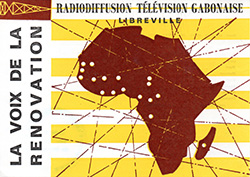 |
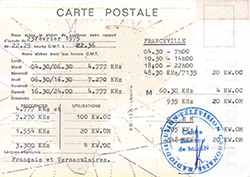 |
The 1975 verification at the left is another example of a slightly modified OCORA card, with "La Voix de la Renovation" replacing "RADIO" along the left side. It's a little blurry, but the bullseye stamp on the back of the card reads "Centre Émetteur de MELEN." This stamp is on many Gabon QSLs of the era, and appears to signify that the "Libreville" transmitter was actually located in the town of Melen. In shortwave generally it is not uncommon for a transmitter to be associated with a nearby city or town rather than the place where it is actually located. |
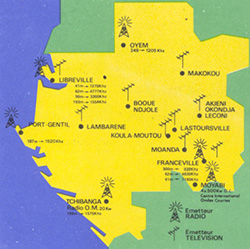 |
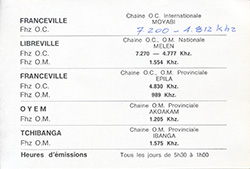 |
As the images at the left, from a 1981 La Voix de la Renovation - Radiodiffusion Television Gabonaise QSL show, Gabon used many different transmitter sites. |
| TCHAD | ||
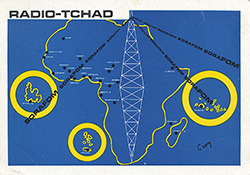 |
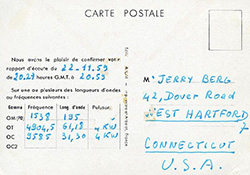 |
Tchad is the northernmost sector of old French Equatorial Africa. Radio Tchad appears to have started out as a service of Radio-A.E.F. in Brazzaville, but it came on shortwave from its own transmitter circa 1956. Its slightly off-mark frequency, 4904.5 kHz., made for a good DX trivia question. It left shortwave around 2013, reappeared briefly in 2016, then departed again, for good. This card is from 1959, when the capital was Fort-Lamy (renamed N'Djamena in 1973). |
| OTHER STATIONS | ||
| FRENCH SOMALILAND | ||
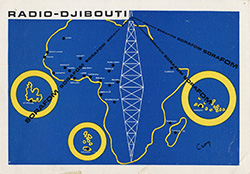 |
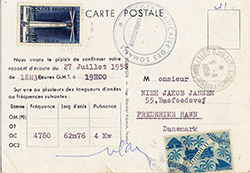 |
First as French Somaliland, then Afars & Issas (1967-1977), then Djibouti (also the name of the capital), this French outpost managed to avoid most of the upheavals that befell the other "Somalilands"—British and Italian—in the years of Somalia's devolution. Djibouti came on shortwave in 1955, and was soon transmitting with 4 kw., 20 kw. in 1983. Off air from roughly 1993, it was back on the DX map at 50 kw. in 2005 as part of a VOA-supported upgrade project, but went silent in 2015. Note the 1958 postmark: "Cote Française des Somalis." |
| MADAGASCAR | ||
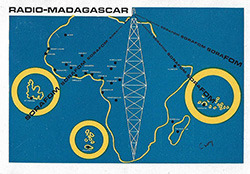 |
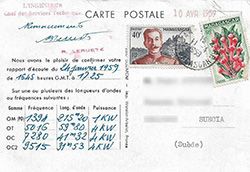 |
It wasn't heard in the U.S. at the time, but Radio Tananarive was reported operating on shortwave as early as 1931. It's current incarnation is still on the air intermittently, and the island nation now also hosts two international shortwave relay broadcasters. |
| SORAFOM REPORTING CARDS | ||
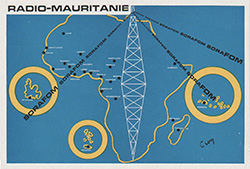 |
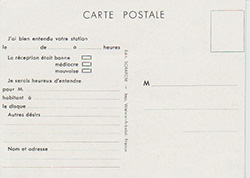 |
A careful look at some SORAFOM cards reveals that they aren't QSLs at all, but rather reporting cards, sent to listeners for making their next report. These two are from Mauritania and French Sudan (Mali). The front is the standard SORAFOM design. The text on the back is not a verification statement, but a blank reception report template, to be filled in by the listener. |
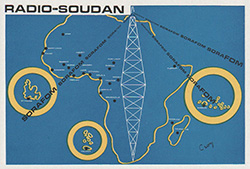 |
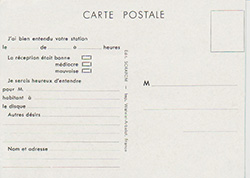 |
|